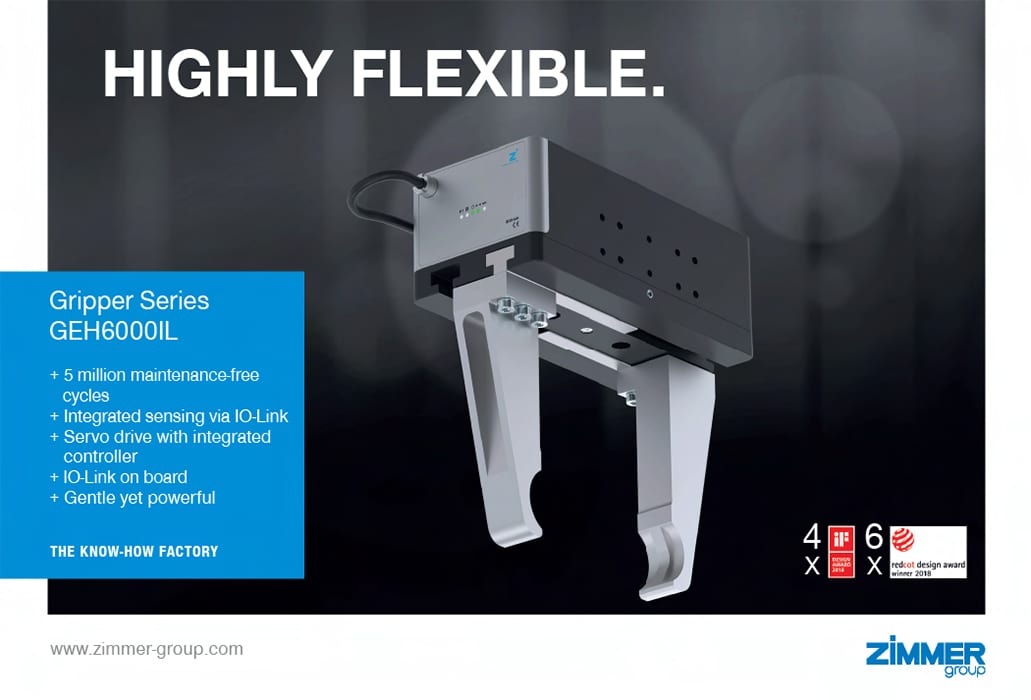
Despite many lightweighting success stories, automotive engineers have only scratched the surface.
Lightweighting Drives EV Range and Performance
By Austin Weber, Senior Editor // webera@bnpmedia.com
The transition to electric vehicles is driving new lightweighting initiatives in the auto industry.
Illustration courtesy Jaguar Land Rover
“Are we there yet?” is an age-old question that back-seat passengers have been asking for decades. Automotive engineers on the lightweighting journey are faced with a similar quandary.
Today, cars and trucks use more lightweight materials than ever in various body, chassis, interior and power train applications. While much of the low-hanging fruit has already been picked, engineers are scrambling to find new opportunities, while also addressing age-old cost, performance and safety concerns.
The transition to electric vehicles is driving new lightweighting initiatives in the auto industry. Whether it is aluminum, carbon-fiber composite or high-strength steel, lightweight materials enable next-generation sedans, sports cars, pickup trucks and sport utility vehicles to achieve increased range and load capacity.
“Lightweighting is beneficial to all classes and types of vehicles,” says Allen Haynes, Ph.D., a materials science engineer who specializes in automotive power train applications at Oak Ridge National Laboratory (ORNL). “It enables reduction in either fuel consumption or battery power demand, lowers emissions, reduces vehicle life cycle carbon footprint, improves vehicle performance, improves safety by reducing braking distances, and allows more cargo in freight vehicles.
“A 10 percent reduction in vehicle weight can result in a 6 percent to 8 percent fuel economy improvement for a conventional vehicle,” explains Haynes.
“The era of rapidly increasing adoption of EVs has clearly arrived, but most forecasts of sales growth require at least 20 years for those vehicles to reach 50 percent of global annual market share,” notes Haynes. “Based on annual global sales, it’s anticipated that approximately 1 billion additional internal combustion engines (ICEs) will be manufactured and sold globally over the next two decades.
“Concurrently, climate science indicates that it’s imperative to immediately reduce the transportation carbon footprint as rapidly as possible,” warns Haynes. “Thus, reducing ICE weight, while simultaneously improving their efficiency, is a crucial (and often overlooked) step in the race to rapid decarbonization of transportation, due to the massive global sales volumes of such vehicles.”
Topology optimization software enables automotive engineers to create designs with minimal mass and maximum stiffness. Illustration courtesy Altair Engineering Inc.
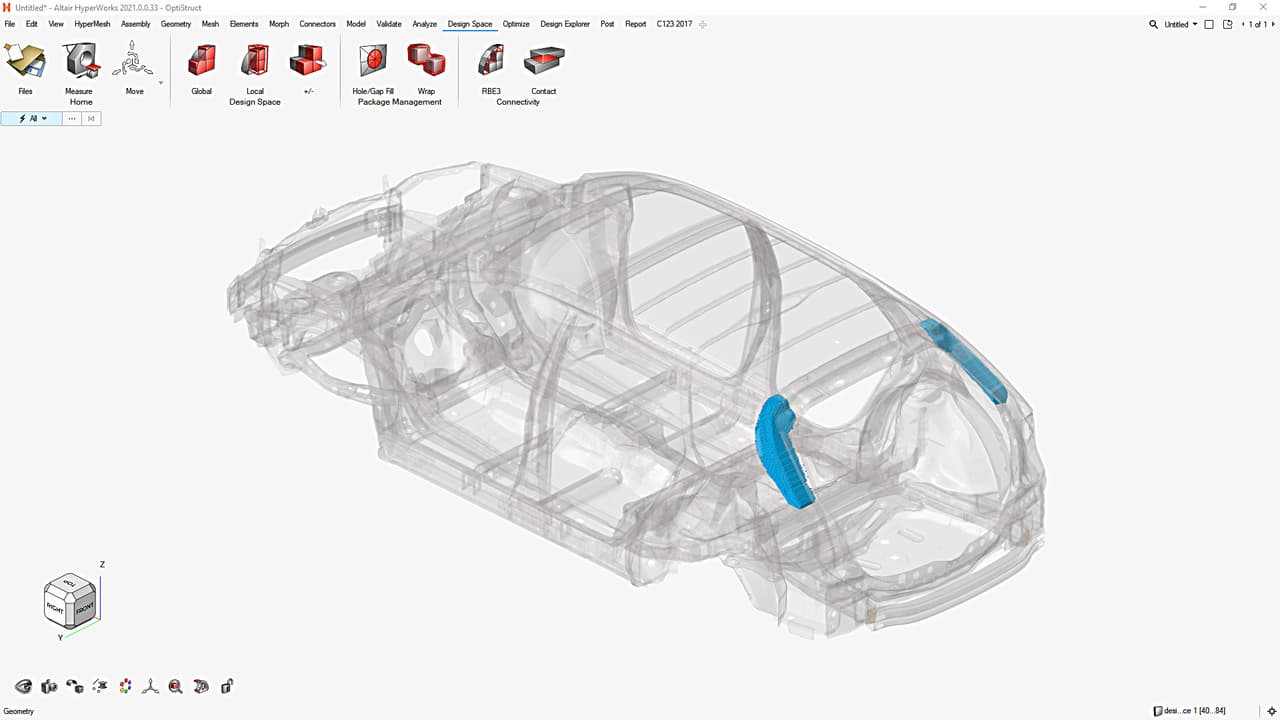
“There’s always opportunity to cut weight in vehicles,” adds Andrew Halonen, president of Mayflower Consulting LLC. “But, performance and crashworthiness must be taken into consideration. Electric vehicle lightweighting efforts require a fine balance between cost, affordability, range and loads.
“Bolt-on parts, such as steering knuckles, are generally much easier to reduce weight,” explains Halonen, who specializes in metal castings and extrusions. “By using aluminum brake calipers, automakers can shave an average of 6 pounds from a vehicle. An average of eight out of 10 brake calipers on ICE cars are iron, but 80 percent of electric vehicles use aluminum parts.
“For instance, the Rivian R1T pickup truck is 260 kilograms heavier than traditional ICE competitors, such as the Ford F-150, Chevy Silverado 1500 and Ram 1500,” says Halonen. “To address that issue, Rivian engineers decided to use aluminum control arms and knuckles instead of the welded steel counterparts used in those Big 3 pickups."
Success Stories
“Replacing material is only part of the lightweighting story,” says Richard Yen, senior vice president at Altair, a leading supplier of simulation software. “In addition to weight reduction, a robust design also has to satisfy safety, stiffness, NVH (noise, vibration and harshness) and durability performance, as well as manufacturing constraints. That requires engineers to consider the correct materials for different performance requirements.
“Multimaterial design is a trend for lightweight automotive structures,” notes Yen. “And, topology optimization provides engineers essential insights to help place the right materials in the right places.
“With topology optimization software, engineers provide boundary conditions and loads,” explains Yen. “The program shows load paths, suggesting the best places to put the material for a particular design.
“It’s a technology for developing optimized structures while considering design constraints like expected loads, available design space, materials and manufacturing methods,” says Yen. “Embedded early in the design process, topology optimization enables the creation of designs, with well-balanced performance considered.
“Today, we’re seeing the convergence of simulation with high-performance computing and artificial intelligence,” Yen points out. “With AI and data analytics technology, historical data and machine learning models can be easily applied to future design iterations faster than starting from scratch each time.”
See us at The ASSEMBLY Show Booth 1223
Marelli engineers created this sheet compression molded suspension steering knuckle for use on the Jeep Compass. It is 50 percent lighter than a cast iron version. Photo courtesy Altair Engineering Inc.
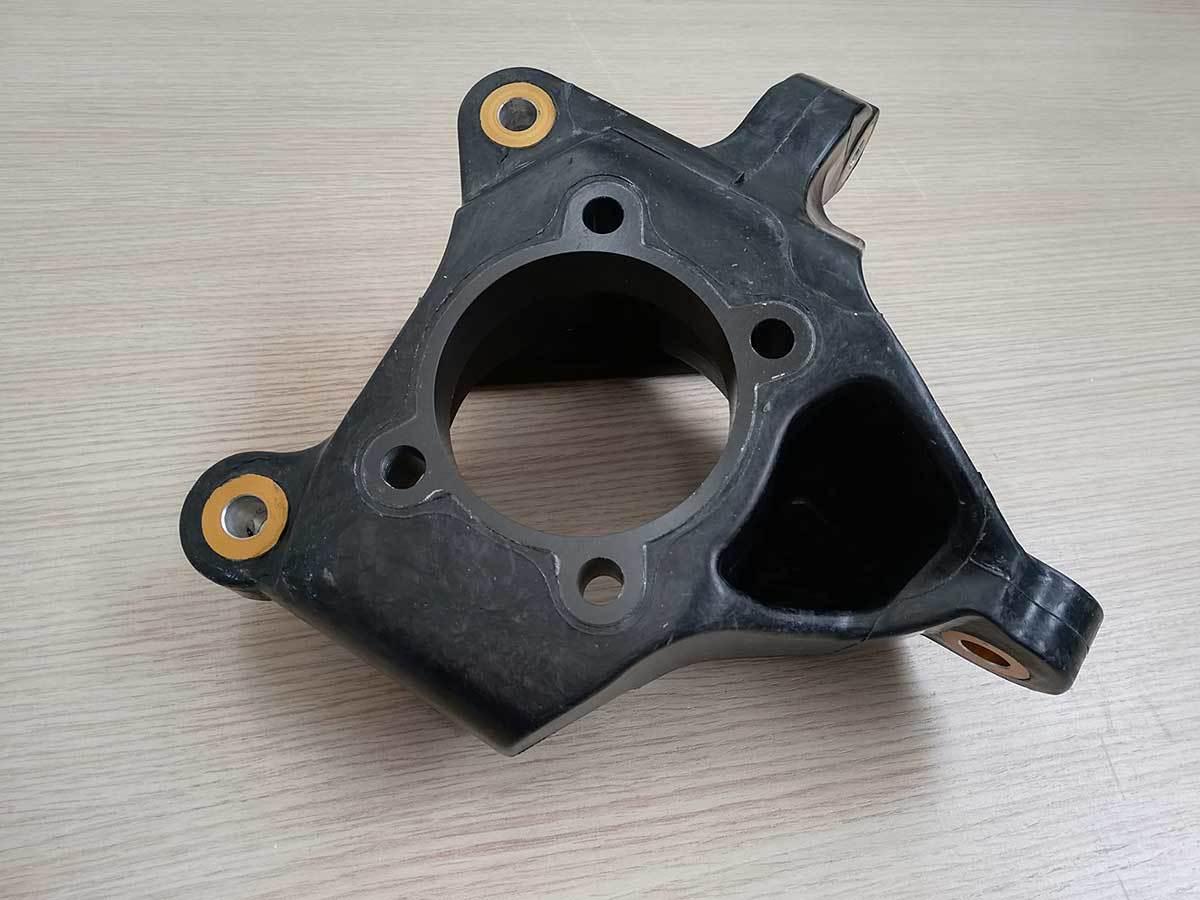
The 2021 Toyota Sienna minivan features a rear seatback that is lighter, easier to assemble and less expensive to produce than its predecessor. Photo courtesy Altair Engineering Inc.
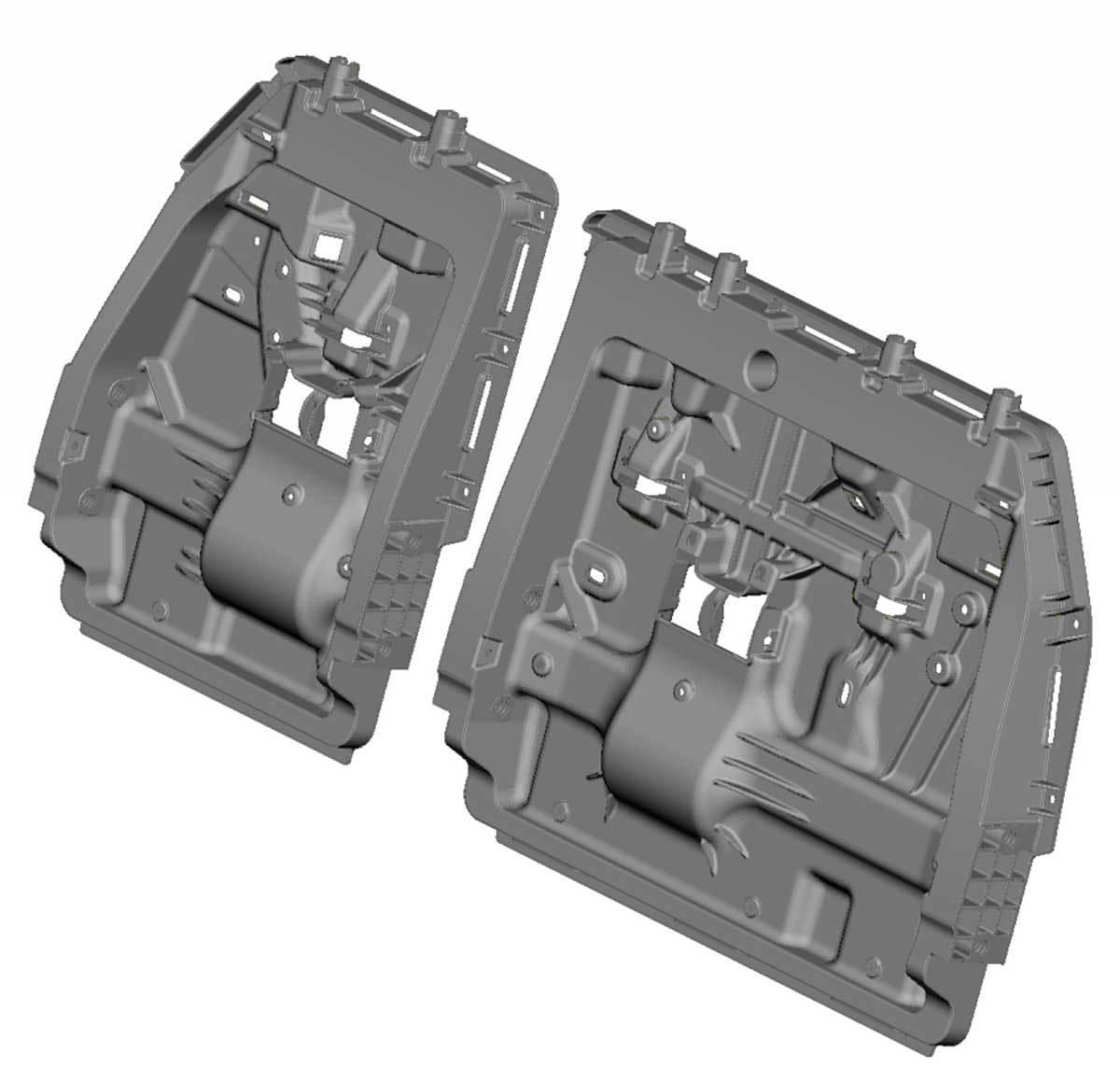
Every year, the Altair Enlighten Award honors achievements in automotive lightweighting and sustainability. In addition to full vehicle mass reduction, a panel of judges consider advancements that enable OEM lightweighting initiatives, such as materials, production processes, design methods and joining technologies.
Last year, Toyota Motor Corp. was honored for a third-row seat back design used in the 2021 Sienna minivan. The injection-molded fiber-reinforced thermoplastic seat back is lighter, easier to assemble and less expensive to produce than alternatives.
“This is a perfect example of parts consolidation, cost reduction and performance improvement,” explains Yen. “The lightweighting effort consolidated 15 steel components to one part with one injection, while driving down costs by 15 percent, reducing mass by 30 percent and improving safety performance two times.”
“Lightweighting doesn’t always have to be more expensive,” adds Todd Muck, senior principal engineer for body design at the Toyota Technical Center in Saline, MI, who worked on the seat project. “Traditionally, resin components for seating have had metal reinforcement, which can add more cost to the process.”
“It is the first of its kind in the way it is designed without inserts as a fully injected seat back,” claims Matt Parkinson, manager of applications development engineering and composite technologies at BASF Performance Materials, which worked with Toyota on the project. “One of the challenges was to ensure a high elongation and impact qualities for the crash requirements.
“At the same time, we focused on strength and stiffness, because the seat serves as a load floor,” says Parkinson. “Toyota also wanted an injection-molded [component] that was a shoot-and-ship part, meaning it was made in one piece, without complex and costly post-processing.”
The award-winning application uses a 35 percent glass-reinforced and impact-modified polyamide PA6 grade of BASF Ultramid.
This aluminum SUV door is 45 percent lighter than its steel counterpart. Illustration courtesy Alumobility
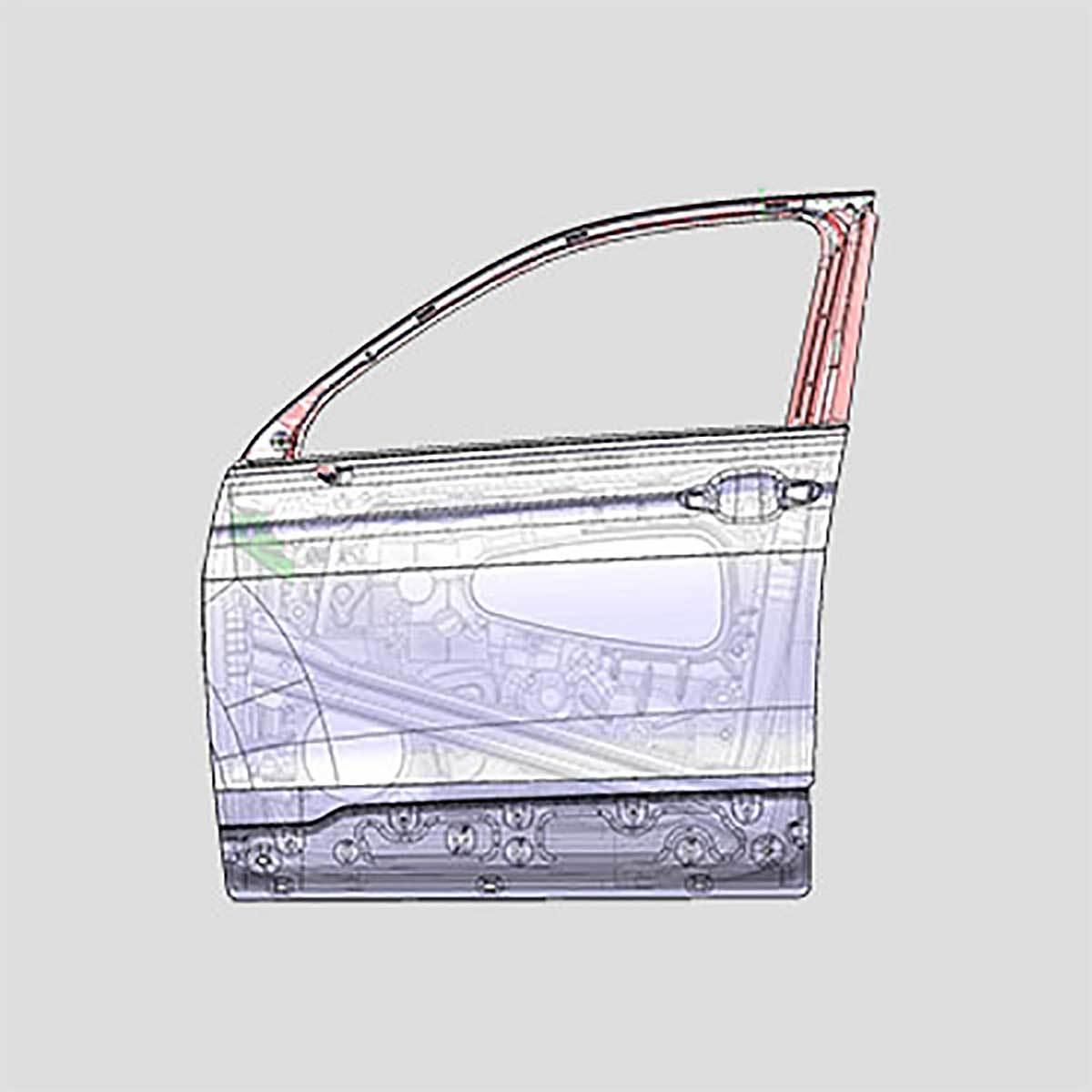
This generic platform for electric and autonomous vehicle applications is made out of lightweight sheet molding compound material. It weighs 20 percent less than an equivalent aluminum subassembly and simplifies the production process. Photo courtesy Teijin Group
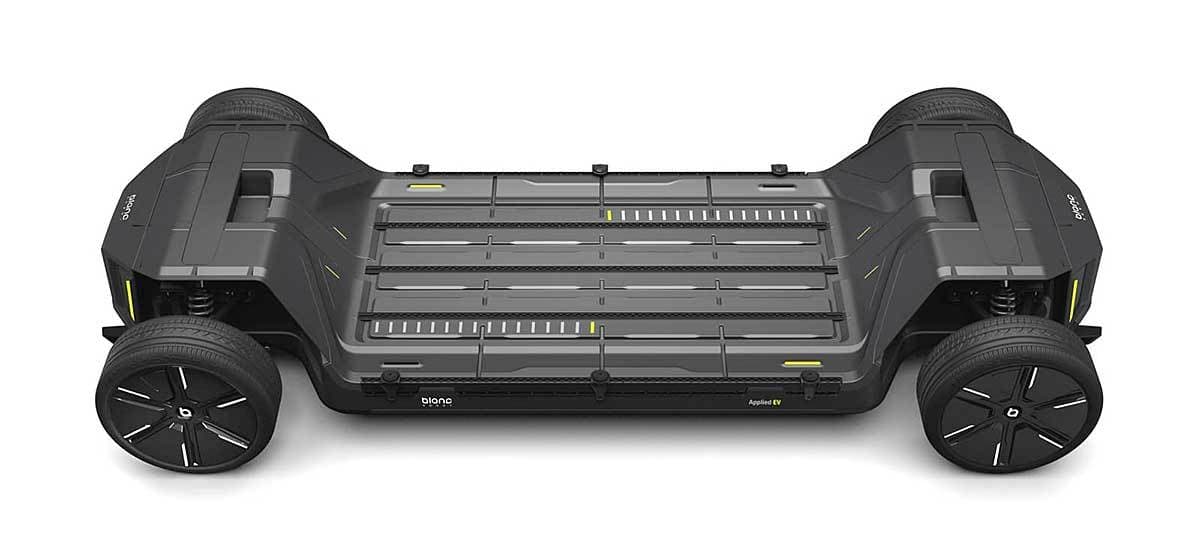
Numerous Options
In addition to polymers, automotive engineers have experimented with many other types of lightweight materials.
“A continuing trend is increased usage of aluminum, substituting for steel and cast iron where possible,” says ORNL’s Haynes. “Aluminum offers much lower density than steel, but substitutions for steels can be limited by tradeoffs with stiffness, fatigue strength, formability, weldability or cost of some of the higher-strength aluminum alloys.
“Another continuing trend is the development of various families of advanced high-strength steels (AHSS) engineered for increased strength, ductility, toughness and fatigue properties, allowing thinner sections to reduce weight,” notes Haynes. “Currently, a third generation of AHSS alloys are under development.”
Demand for affordable, lightweight composites also continues to increase in the auto industry. In spite of challenges related to cost and production volume, use of carbon-fiber composites is gradually expanding. And, one technology that may spur greater use of the material is additive manufacturing.
“Printed polymer composites, often whisker- or fiber-reinforced, are being evaluated [as potential alternatives] for some vehicle components where injection molding or other processes do not provide adequate solutions,” says Haynes. “Printing is more costly, but it can be an ideal route for prototyping, low-volume production (since in some cases it can eliminate the need for expensive fixturing, tooling and molds), customization, or for providing legacy parts no longer in [daily production].”
Another increasing trend is the use of mixed-material applications where a variety of different steels, aluminum alloys, magnesium components (usually die-cast interior parts), plastics and composites are integrated to reduce weight locally, by component, wherever possible.
“Of particular importance in supporting this trend is the development of advanced multimaterial joining strategies appropriately tailored to each pairing of materials to enable adequate joint strength, fatigue life, corrosion resistance and manufacturing rates,” says Haynes. “Joining of multimaterial systems continues to be an area of significant focus.
“The use of multimaterial lightweighting strategies in automobiles requires joining of dissimilar materials, which can create significant challenges associated with bond strength, microstructural stability, manufacturing rates or corrosion,” Haynes points out.
This thermoplastic honeycomb sandwich panel is lightweight, rigid and recyclable. Photo courtesy EconCore N.V.

This lightweight battery enclosure enables parts count consolidation, packaging efficiencies and mass reduction. Illustration courtesy Forward Engineering North America LLC

Lightweight Metals
Haynes and his colleagues at ORNL are currently working on several R&D projects involving lightweight materials for automotive applications. For instance, late last year, the U.S. Department of Energy’s Vehicle Technologies Office launched a new Lightweight Metals Core Program that involves engineers at ORNL, Argonne National Laboratory and Pacific Northwest National Laboratory (PNNL).
“This program focuses on developing a scientific understanding of methods that allow local microstructural modification and improvement of cast aluminum, sheet aluminum, and cast magnesium alloys used for automotive body and frame applications,” says Haynes. “The concept of the program is to research and develop novel methods of materials processing that improve the localized formability, strength, functionality, corrosion resistance or joining strategies of existing lightweight alloys.”
One of ORNL’s research efforts within this program is to print reinforcing material or additional structures on top of existing aluminum alloy sheet or castings. The goal of the project is to “create a hybridized process where the application of additive manufacturing is limited to a very localized area of a component, enabling a specific additional functionality or benefit only in the area of a part where it is needed.” According to Haynes, this could benefit both traditional automobiles and EVs.
ORNL has also developed an additive manufacturing process for metal-metal composites. The process prints an internal mesh or skeleton from a high-strength, high-temperature, high-density material and then overcasts and infiltrates it with a lower density, lower melting point material, such as aluminum. The result is a metal-metal composite structure with a lower density that can be used for locally tailored mechanical, acoustic or thermal properties within the structure.
“A very recent and significant development is the emergence of new printed aluminum alloys with substantial increases in strength and temperature tolerance compared to conventional high-temperature aluminum materials,” says Haynes. “[We have] developed multiple new families of advanced aluminum alloys that are printable. They are specifically designed to take advantage of the rapid solidification rates offered by certain additive manufacturing processes.
“This is a particularly intriguing area of lightweight materials research, since additive manufacturing has traditionally been viewed as having the primary advantage of offering geometric design freedom,” Haynes points out. “But, additive manufacturing can add even more value for certain lightweight alloys.”
“For instance, laser powder bed printing of certain types of aluminum alloys provides rapid solidification effects that result in extreme microstructural refinement and formation of highly stable non-equilibrium solid phases, some of which have never been previously identified,” claims Haynes.
“These new microstructures can result in substantial increases in alloy strength, as well as stability at higher temperatures, as a direct result of the cooling rates of the laser powder bed printing process,” explains Haynes. “[We are currently] printing the first set of pistons from one of these newly designed aluminum alloys for engine testing later this year.
“These newly designed lightweight alloys have potential to change the paradigm for printing aluminum parts, since it offers both geometric complexity and improved material properties,” Haynes points out. “As cost margins change in the years ahead, and as general printing volumes scale up and begin to reduce the cost of equipment and feedstocks, additive manufacturing will offer some unique pathways to further design-driven weight reductions in vehicle frames, chassis, interiors and power trains, as well as enabling stronger materials.
“Stronger and stiffer alloys for frame, body and chassis applications will enable thinner sheet materials, extrusions and castings, allowing further weight reductions,” predicts Haynes.
Carbon nanotube technology enables engineers to develop electrical conductors that feature better mechanical strength, lighter weight and higher current capacity. Illustration courtesy Oak Ridge National Laboratory

Engineers are developing lightweight battery enclosures for electric vehicle applications. Photo courtesy Continental Structural Plastics Inc.
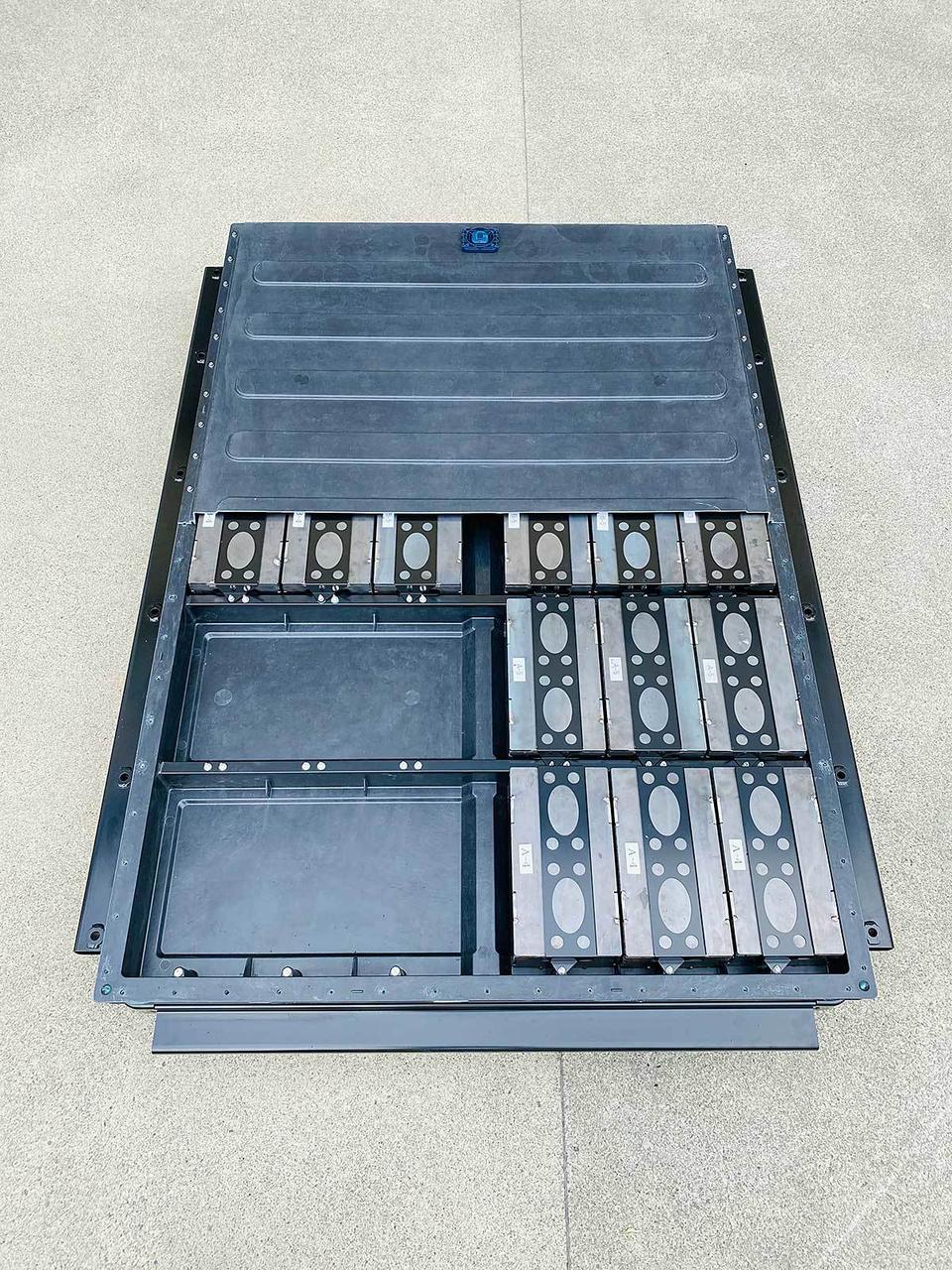
iElectric Vehicles
Traditionally, the goal of lightweighting has been to improve the fuel economy of ICE vehicles. However, the transition from ICEs to electric vehicles changes both the goals and design considerations of lightweighting efforts.
“EVs have a fundamentally different architecture than ICE vehicles, with large battery packs as the dominant feature rather than a large engine bay,” says Anthony Schiavo, a senior analyst at Lux Research Inc. “The need to secure a large, heavy battery pack at the bottom of the vehicle and the desire to use one platform for multiple vehicles will drive the automotive industry back into a body-on-frame arrangement.
“[A] body-on-frame structure favors high-strength steels and aluminums as the primary structural elements, as the extra weight of these metals will mostly be at the bottom of the vehicle, where it will have a minimal impact on performance,” claims Schiavo.
However, higher strength, affordable lightweight alloys need to be developed for battery enclosures and electric motor housings.
“[They must] offer excellent impact protection, while also providing very good thermal properties, for improved management of the heat generated by batteries and electric motors in EVs,” says ORNL’s Haynes. “This is a significant metallurgical science challenge, since the microstructures and mechanisms that improve mechanical properties in an alloy often simultaneously reduce thermal transport through the material.”
Those challenges could open the door for composites.
“The shift to electrified vehicles has created an incredible opportunity for us to work on fresh, clean-sheet designs,” says Adam Halsband, managing director of Forward Engineering North America LLC. “These new design opportunities allow us to employ the latest composite materials, and develop highly integrated mass and cost-efficient structures. Now, more than ever, OEMs depend on upstream suppliers to support innovative product development.
“The shift has been disruptive in terms of how people look at mass on a vehicle,” adds Halsband. “But, the things that really matter to automakers today are cost effectiveness, flexibility and scalability. Any lightweight automotive material needs to be cost effective and easy to integrate.”
“The performance of new EVs is mind boggling,” notes Halsband. “The idea that a typical EV sedan today can deliver acceleration that even the fastest sports car of a few years ago struggled to deliver is amazing.
“Right now, the race is on to drive down the cost of these new products and scale up these new platforms,” says Halsband. “Composites are perfectly positioned to cost efficiently deliver the performance, packaging efficiency and scalability that the automotive industry is demanding.”
The new R1T pickup truck uses aluminum control arms and knuckles to help reduce weight. Photo courtesy of Rivian Automotive Inc.
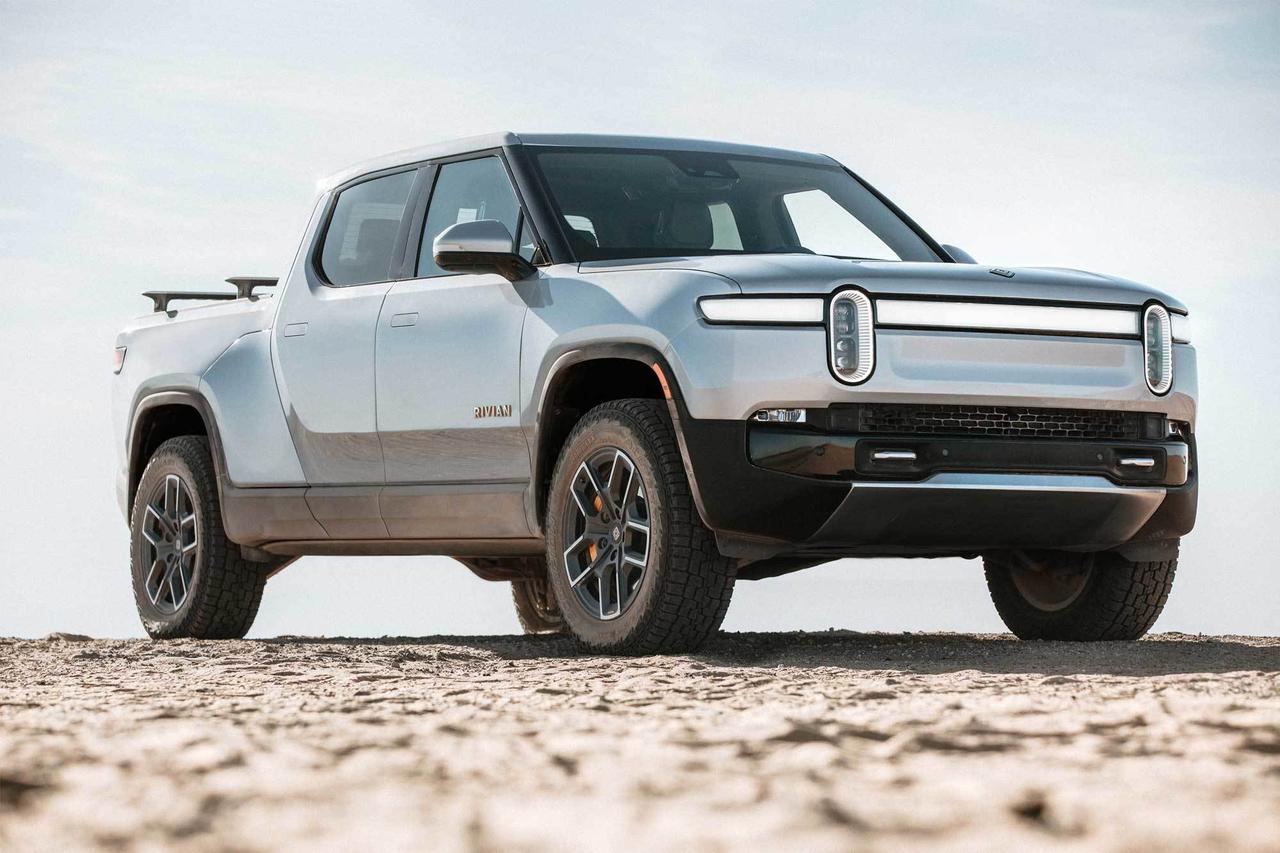
EV Applications
Battery enclosures may be one way for composites to gain more acceptance in the cost-conscious auto industry. Traditionally, most housings are made out of aluminum or steel.
“OEMs are pushing the envelope of passenger vehicle design, [forcing engineers] to come up with more efficient and flexible ways to package the energy storage within electric vehicles,” says Halsband.
“A second, and equally important, driver is the evolution of regulations [governing] rapidly evolving power train technology,” Halsband points out. “New global safety standards are driving more stringent performance requirements from battery enclosures, which requires engineers to ensure their designs meet these evolving requirements.”
Forward Engineering was recently involved in an R&D project that developed a lightweight battery enclosure made out of sheet molding compound (SMC). Other companies participating in the collaborative effort included Evonik, LION Smart, Lorenz and Vestaro.
“The modular, mixed-material design exploits the structural and thermal properties of SMC,” says Halsband. “[We were] able to design structural modules which mitigate the need for cross members within the enclosure, resulting in parts count consolidation, packaging efficiencies and mass reduction.
“Through our simulation-driven design approach, [we were able] to meet the most stringent new regulatory requirements and realize weight savings of approximately 10 percent vs. a comparable capacity pack,” explains Halsband. “In addition to the mass savings, packaging efficiencies of the design provide engineers with more design freedom in the pack-to-body integration.
“The new SMC compound developed by Lorenz provides us with exceptional design freedom thanks to its mechanical performance and ease of processibility,” explains Halsband. “These attributes enabled the design of a highly integrated pack cover that incorporates multiple elements into a single molded structure.
This new honeycomb core features higher heat performance, better dimensional stability and lower water absorption vs. honeycomb structures made with incumbent thermoplastics. Photo courtesy EconCore N.V.
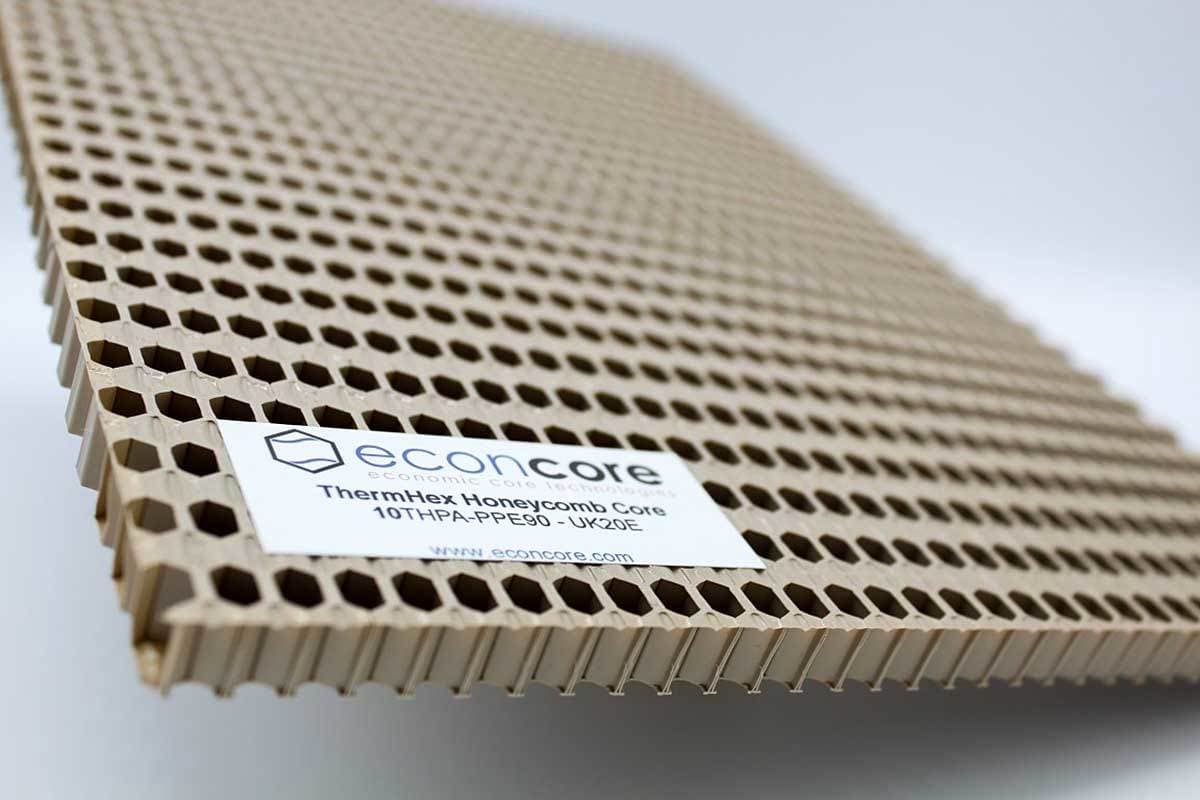
“Integration of the cross member function into the structural module housings eliminated redundant components and fasteners,” adds Halsband. “Using a mix of materials, and clean sheet approach to the pack segmentation, allowed the team to simplify the design, further enabling parts consolidation and reduction in the number of joints in the system.”
Another lightweight battery enclosure project in Europe involves engineers from EconCore N.V., a Belgian company that has developed thermoplastic honeycomb sandwich panels that are recyclable.
“There’s no doubt there are some interesting opportunities to reduce weight using composite materials,” says Tomasz Czarnecki, chief operating officer at EconCore. “We believe there are even greater potential benefits from using honeycomb sandwich materials, which have incredible rigidity, while being extremely light, compared to aluminum or steel alternatives, or compared even to monolithic composites.”
EconCore already has experience using thermoplastic honeycomb material in vehicle interiors, which can be compression molded to produce three-dimensional shapes. One of the company’s customers, a Tier 1 supplier, recently supplied Hyundai with a sandwich part featuring polypropylene honeycomb and glass mat thermoplastic composite skin. By using the material, Hyundai engineers were able to reduce the weight of trunk floors in the Creta SUV by 20 percent.
“In addition, [this] is offering benefits regarding recyclability and short-cycle, cost-effective convertibility by compression molding,” explains Czarnecki. “Other commercial applications for the technology [include] vibration dampeners.”
“In the future, we expect to see more applications involving interior parts, such as door panels, headliners, seatbacks and parcel shelves,” notes Czarnecki. “Anything that needs to be lightweight, rigid and recyclable is a potential candidate for thermoplastic honeycomb sandwich structures.”
EconCore recently launched next-generation honeycomb made from recycled PET (RPET) and high-performance thermoplastics (HPT).
“These developments started as a result of a pull from the market demanding more sustainable materials and the shift to focus toward performing and easily processable thermoplastic solutions with high-end applications, for instance within the aerospace and public transportation markets,” says Czarnecki.
According to Czarnecki, the use of RPET honeycomb provides a sustainable solution with a good life cycle assessment and low carbon footprint, which fits world-wide sustainability targets. HPT honeycombs meet the demand for cost-effective, short cycle processable high-end thermoplastic composites that are lightweight, strong, fatigue resistant and recyclable.
EconCore has also developed new honeycomb cores for laminated sandwich panels for EV battery structures. They are made with SABIC’s NORYL GTX resin, a polyphenylene ether blend, and EconCore’s proprietary technology.
“Thermoplastic honeycomb structures deliver a high performance-to-weight ratio and efficient energy absorption under impact,” explains Czarnecki. “Combined with an effective, in-line integrated sandwich panel production technology, this weight reduction has positive implications for overall production cost savings and environmental responsibility. In addition to reducing raw material use, the honeycombs support recyclability.
“The new honeycomb structures deliver higher heat performance, greater dimensional stability and lower water absorption than alternative materials,” claims Czarnecki. “It also exhibits high load-bearing capacity up to 180 C.”
Source: U.S. Department of Energy
Making Motors and Batteries Lighter
Electric traction motors and batteries are another focus of EV lightweighting efforts.
Engineers at PNNL have increased the conductivity of copper wire by 5 percent. Higher conductivity means that less copper is needed for the same efficiency, which can reduce the weight of electric vehicles.
PNNL recently worked with General Motors to test out the copper wire in EV motor components. As part of the R&D project, engineers validated the increased conductivity and found that it also has higher ductility.
“In other physical properties, it behaved just like regular copper so it can be welded and subjected to other mechanical stresses with no degradation of performance,” says Glenn Grant, a PNNL engineer who served as principal investigator on the project. “This means that no specialized manufacturing methods are necessary to assemble motors.
“GM engineers verified the higher conductivity copper wire can be welded, brazed and formed in exactly the same way as conventional copper wire,” claims Grant. “This indicates seamless integration with existing motor manufacturing processes.”
Engineers at ORNL are also experimenting with new ways to make lighter EV motors.
“Electric motors are basically a combination of metals—steel laminations and copper windings,” says Burak Ozpineci, manager of ORNL’s Electric Drive Technologies Program and leader of the Power Electronics and Electric Machinery group. “To meet electric vehicle targets and goals, we need to increase power density of the electric drive and reduce the volume of motors by eight times, and that means improving material properties.”
Ozpineci and his colleagues are experimented with carbon nanotube technology to develop electrical conductors that feature better mechanical strength, lighter weight and higher current capacity. The goal is to improve performance, reduce volume and increase the power density of EV traction motors.
ORNL engineers recently created a composite that increases the electrical current capacity of copper wires, providing a new material that can be scaled for use in ultra-efficient, power-dense motors. The material can be deployed in any component that uses copper, including more efficient bus bars and smaller connectors for EV traction inverters.
To produce a lighter weight conductive material with improved performance, the engineers deposited and aligned carbon nanotubes on flat copper substrates. That resulted in a metal-matrix composite material with better current handling capacity and mechanical properties than copper alone.
Batteries are always the proverbial thorn in the side of EV lightweight efforts. In electric cars, battery packs account for approximately one-third of a vehicle’s total weight. To address that issue, automotive engineers are using generative design software and simulation tools to create lighter batteries.
“Batteries are the new fuel tanks in electric vehicles,” says Rani Richardson, composites and additive manufacturing industry consultant at Dassault Systemes. “They need to store as much energy as possible to minimize range anxiety, as well as maintain safety in case of unexpected events. Batteries are highly complex systems, requiring advanced engineering methods at all levels: from chemistry to cell engineering, to module and pack engineering, and finally integration into full vehicles.
“[We] provide battery solutions for all of these scales,” claims Richardson. “Our CATIA brand, for instance, provides battery libraries to efficiently use 1D simulation for cells, modules and packs. In this system-level representation, the aging, thermal and electrical behaviors of each cell are combined to understand how an entire module of cells behaves.
“With the molecular level modeling characteristics, the mechanical, thermal, diffusion and electrical behavior of the individual cell can then be simulated in 3D,” explains Richardson. “SIMULIA capabilities are extensively used on cell and full battery modules to improve strength, stiffness and safety in abuse test scenarios. Finally, battery packs integrated into full vehicle models can be simulated for realistic test conditions.”
European Engineers Tackle EV Lightweighting Challenges
Engineers at the Technological Institute of Aragon (ITAINNOVA) in Spain are coordinating a new European Union initiative to develop lightweight components for electric vehicles. The goal of the LEVIS project is to create multimaterial production technologies that include recyclable resins and bio-based carbon fiber composites.
Thirteen other organizations are involved in the two-year project, including Cenex Nederland, Marelli Suspension Systems and
Steinbeis-Europa-Zentrum.
“[Because] electric vehicles are powered by batteries that often carry considerable weight, car manufacturers and suppliers must seek new lightweighting technologies to compensate for this excess weight in other car components,” says Agustín Chiminelli, scientific coordinator of the LEVIS project. “These technologies can directly contribute to improving vehicle
efficiency in terms of kilowatt hours consumed per kilometer, as well as vehicle autonomy, and also reduce environmental impact.”
Chiminelli and his colleagues will be focusing on three different components: a cross beam, a suspension control arm, and a battery clamping and packing system.
"We will use multimaterial solutions based on thermoplastic carbon-fiber compounds integrated with metals, which will be
produced through a set of profitable and scalable manufacturing technologies," explains Chiminelli. “Thanks to their excellent mechanical properties, these composites, properly combined with metals, are ideal for light applications.
“LEVIS aims to develop [new technology] for these multimaterial components based on resins and environmentally friendly
reinforcement systems, cost-effective manufacturing processes, optimized joints, advanced simulation methodologies and structural integrity monitoring technologies,” Chiminelli points out. “The combination of these developments will allow us to obtain lightweight components.”
“The new lightweight components will be developed using a circular approach,” adds Theodora Skordili, business development
manager at Cenex Nederland. “This means that we will pay special attention to the use of recyclable materials and the design of the components so that, at the end of the useful life of the components, nothing will be wasted and each part can be recycled or reused for the same component or for others. The useful life of these components will be optimized, and they will be designed to allow simple and efficient disassembly and reuse.”
september 2021 | ASSEMBLYMAG.com

september 2021
Scroll to
read full article
